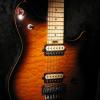Andy's deck has 64 edge pips, no tactics icons, and only four units with three health. I've never played with or against it, but to my understanding, it's extremely draw dependent. When Mobilize the Squadron or Defense of Yavin IV are in play, it can flood the board with cheap units and overwhelm the opponent's defenders. The four Rebel Assaults, the single copy of Rapid Fire, and the two copies of Surprising Maneuver can obliterate defenders before edge so the swarm can strike without fear of even Palpatine.
But that's when the deck draws well. When it draws poorly, the low edge, lackluster icons, and fragile units mean it is unlikely to win.
David Tietze (GreedoShotFirst) also made it into the Top 16 with a vehicle deck:
Mercenary Contacts affiliation (Smuggler/Rebel 7-reserve)
2 x Across the Anoat Sector (74)
2 x Breaking the Blockade (162)
2 x That Bucket of Bolts (168)
2 x Defense of Yavin 4 (8)
2 x Rogue Squadron Assault (141)
2 x Command and Control (152)
This deck has 80 pips, but the average per pod is 6.7, only slightly above the average for Andy's deck of 6.4. Again, I haven't played with or against it. However, I suspect the strategy is similar: Flood the board with units by activating Defense of Yavin 4 or playing Well Paid, then use tricks to bypass edge or render it irrelevant. For this deck, those tricks include the Sleuth Scouts, Han, and Surprising Maneuver, as well as Rebel Assault and the Resupply Depot, which can take a defender out of the the second or third conflict by giving a Sleuth Scout tactics.
You'll notice a theme with all three decks: They're aggressive, draw-dependent decks that don't care about edge. For someone who is used to playing a four-cost unit with four icons every turn, then winning edge and using tricks to double-strike, piloting such decks may be frustrating. But if you play to their strengths, they should be fun.
Your deck appears to be taking a slower and more methodical approach. While it shares Rogue Squadron Assault with the three decks presented above, it eschews the resource acceleration and control available from Defense of Yavin IV, Well Paid and Mobilize the Squadrons in favor of Pilot Ready Rooms, which only pay off on the turn they're played if you follow up with a pilot. In an ideal world, the deck builds a board of fighters with Biggs in play to provide edge bonuses, sends those fighters to an objective to destroy it, then has Leia sacrifice herself to gather the fuel they need to go somewhere else.
Unfortunately, I don't think many of the fighter sets work well with the "build, attack, win edge and strike" strategy. To illustrate, let's compare They'll Never Stop Us to Pushing Back the Empire. Since these two sets came out in the same cycle, they both benefited from years of experience with the game, so they should have a similar power level.
Let's start with the objectives. With two resources and text, They'll Never Stop Us is an example of power creep since Core, when two-resource objectives would often have four health or no text. However, the text can be extremely situational. Even in decks designed to abuse it, I was rarely able to draw more than two or three cards, and I could only capitalize on those if I had a unit left behind for defense or a second attack. Pushing Back the Empire does little to help with edge by itself, but its resource pump can be used almost every turn in the right deck and requires no sacrifice. In contrast, getting two resources from They'll Never Stop Us means getting none the next turn.
But what about the four-cost units? Both have three health, three pips, elite, two guns, a bomb, and a tactics icon. However, Cassian is much stronger. He's vulnerable to Force Choke and other effects that target characters, but his bomb is black, and his text is likely to let you re-use another unit or at least frighten your opponent so much they invest heavily in keeping him focused down. Red Three is immune to Force Choke, but unless you happen to be playing pilots on foot or facing Tarkin, his text is useless.
Cassian's two-cost units outshine Red Three's as well. The Rebel Saboteurs have no tactics, but they can stop potentially deadly actions, reactions and interrupts from hand or protect important units and objectives on the board. On foot, Biggs is less impressive; he's a unique unit that needs to win edge to do more than one damage. When he's piloting a vehicle, he can give edge, but for the edge bonus to be significant, you need to send several fighters to one location and have a unit in play with the strike economy to capitalize on winning edge. Unfortunately, with the exception of the otherwise unremarkable Red Three and the overcosted Rogue Squadron, no fighter has two guns and a tactics. Nor do fighters generally have the ability to do three damage in one strike, which makes it difficult for them to trade blows with enemy units and come out ahead.
Red Squadron X-Wing has the distinction of being a two-cost unit with two black icons and the potential to gain Targeted Strike. Two-cost units have come a long way since the core set, when blank boxes and white icons were the norm. But because the X-Wing only has one gun, its Targeted Strike will rarely feel powerful unless it happens to be augmented by an Astromech Droid and piloted by Wedge or Luke.
In theory, Coordinated Strike can make up for fighters' generally poor strike economy and allow the Light Side to capitalize on winning edge by allowing two units to strike at once. But when I tried to play decks designed to take advantage of Coordinated Strike, I rarely found it useful. To use it, you need to win edge with two units in the conflict while holding a card and a resource back, or have so many units with black icons on the board that you can afford to lose edge but still have enough units to pull off a one-two combo. In the latter situation, the event doesn't seem to provide much benefit. In fact, it is strongest when paired with units who have great strike economy, such as Yoda or the aforementioned Cassian.
In general, the more recent fighter sets seem stronger with characters or capital ships than they are with fighters. A Legend Begins is a case in point. The two copies of Tactical Planning it contains can help fighter decks win edge, and if the objective is out, knock an enemy out of the engagement. While you could use A Legend Begins to neuter or knock out a Rogue Squadron X-Wing's sole foe, I'd rather pair it with the Luke from A Hero's Trial, who can destroy an objective by himself if he happens to have an enhancement.
With enough investment, fighters can eclipse characters in terms of strike economy. For example, Red Three and Rogue Squadron are sure to make even Vader and Palpatine shake if they're piloted by the Luke from A Hero's Resolve, who can push their gun count to the often-fatal three while giving them a second tactics icon. An Astromech Droid Upgrade or the version of Wedge that comes with A Legend Begins can also boost the two fighters' icon counts, but if that's all they're doing, they're merely substitutes for a Jedi Lightsaber.
Besides, the more you invest in a single fighter, the less you have for edge, and the more you lose when that fighter is removed. The designers tried to make up for that with the free recursion from Stay on Target and the card draw effects on Rogue Squadron Assault, They'll Never Stop Us, Sacrifice of Heroes, Rogue Squadron, and R5-D8, but those effects are only in play occasionally. Furthermore, they often provide card draw not in the deployment phase, when it can alter what you play and help you evaluate your edge hand before attacking, but during or after a conflict, when every card except a free event can be useless.
In short, playing fighters as you would characters is hard. As you observed, fighter decks often feel underpowered unless they draw the right cards at the right time. Instead of trying to mitigate that, I'd recommend embracing it. After all, we would not remember the pilots from the films so fondly if they went into battle knowing they would win. Their sacrifice and ultimate victory means more because it was unlikely.
Alternately, accept that the battle between Light and Dark must be fought on multiple fronts. Instead of trying to build a fighter deck, ask how cunning tacticians, wise Jedi, and sneaky smugglers can work alongside daring pilots to achieve their shared goal of freedom from the Empire.



 Sign In
Sign In Create Account
Create Account




 Back to top
Back to top










